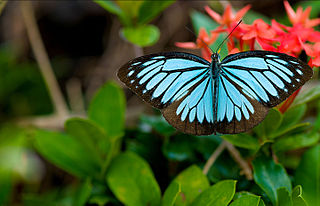Related Research Articles

Pareronia valeria, the common wanderer or Malayan wanderer, is a medium-sized butterfly of the family Pieridae, that is, the yellows and whites, and is found in India and Southeast Asia. The butterfly found in India is sometimes considered as a separate species, Pareronia hippia.

Curetis bulis, the bright sunbeam, is a species of butterfly belonging to the lycaenid family. It is found in Asia.

Apporasa is a genus of butterflies in the family Lycaenidae, the blues. The genus is monotypic containing only Apporasa atkinsoni, the crenulate oakblue. It is found in the Indomalayan realm.
Cosmopterix adrastea is a moth of the family Cosmopterigidae. It is known from Cuba.
Cosmopterix amalthea is a moth of the family Cosmopterigidae. It is known from Cuba.
Cosmopterix galapagosensis is a moth of the family Cosmopterigidae. It is known from the Galapagos Islands.
Cosmopterix lespedezae is a moth of the family Cosmopterigidae. It is known from the United States.
Calliprora platyxipha is a moth of the family Gelechiidae. It is found in Brazil.
Thiotricha pancratiastis is a moth of the family Gelechiidae. It was described by Edward Meyrick in 1921. It is found in Japan and Assam, India.
Stenoma chromotechna is a moth of the family Depressariidae. It is found in Brazil (Amazonas).
Antaeotricha rhipidaula is a moth of the family Depressariidae. It is found in Guyana.
Antaeotricha segmentata is a species of moth of the family Depressariidae. It is found in Guyana.
Antaeotricha diffracta is a moth of the family Depressariidae. It is found in French Guiana.
Psittacastis eumolybda is a moth in the family Depressariidae. It was described by Edward Meyrick in 1926. It is found in Peru.
Hypercallia alexandra is a moth in the family Depressariidae. It was described by Edward Meyrick in 1909. It is found in Peru.
Imma flammula is a moth in the family Immidae. It was described by Alexey Diakonoff in 1978. It is found in Nepal.
Moca chrysocosma is a moth in the family Immidae. It was described by Alexey Diakonoff in 1967. It is found on Luzon in the Philippines.
Orthonevra flukei (Sedman, 1966), Fluke's Mucksucker, is an uncommon species of syrphid fly It has been observed in the Western United States. Hoverflies get their names from the ability to remain nearly motionless while in flight. The adults are also known as flower flies for they are commonly found around and on flowers from which they get both energy-giving nectar and protein-rich pollen. Larvae for this genus are of the rat-tailed type. O. flukei larvae have been described.

Brachyopa diversa , the Pale-striped Sapeater, is a rare species of syrphid fly. It has been observed in the northeastern part of North America. Hoverflies get their names from the ability to remain nearly motionless while in flight. The adults are also known as flower flies for they are commonly found around and on flowers, from which they get both energy-giving nectar and protein-rich pollen. Larvae for this genus are of the rat-tailed type. B.diversa larvae have not been described.

Sphiximorpha willistoni, or Williston's wasp fly, is a rare species of syrphid fly found in eastern North America. It is a strong wasp mimic. Hoverflies can remain nearly motionless in flight. The adults are also known as flower flies for they are commonly found on flowers, from which they get both energy-giving nectar and protein-rich pollen. Larvae in this genus are found in sap runs of trees.
References
- ↑ funet.fi
- ↑ Bull. U.S. Nat. Mus. 257 : 151
 This article incorporates text from this source, which is in the public domain .
This article incorporates text from this source, which is in the public domain .